From the Archives ...
Sea run trout tactics – Craig Vertigan
Sea run trout tactics – Craig Vertigan
During the trout off-season I tend to spend a bit of time chasing bream, to continue getting a fishing fix, and spend time tying flies and dreaming about the trout season to come. It’s a time to spend doing tackle maintenance, stocking up on lures and dreaming up new challenges and goals for the trout season ahead. When the new season comes around I usually spend the first few months targeting sea runners. Sea run trout are simply brown trout that spend much of there lives out to sea and come in to the estuaries for spawning and to feed on whitebait and the other small endemic fishes that spawn in late winter through spring. Mixed in with the silvery sea runners you can also expect to catch resident fish that have the typical dark colours of a normal brown trout as well as atlantic salmon in some of our estuaries that are located near salmon farm pens. Living in Hobart it is quick and easy to do a trip on the Huon or Derwent and is a more comfortable proposition compared to a trip up to the highlands with snow and freezing winds to contend with.
Read more ...Please check all relevant authorities before fishing - www.ifs.tas.gov.au and dpipwe.tas.gov.au . Don't forget issuu.com/stevenspublishing for years of back issues !
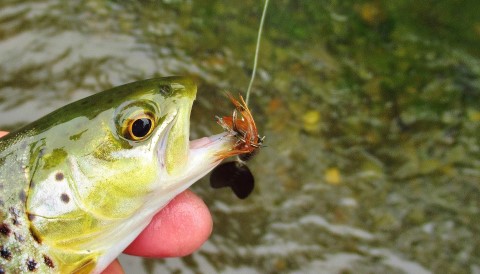 As much as I wanted to do today, fast water fishing was taken off my where to fish list, I still headed to the same river and started the spin session in the slower flowing waters of the Meander River. The same waters where the river bottom is covered in green algae and brown slime, the water level was up by 40mms so that gave a little more space between the lure and the river bottom today. I was in the river by 7:10am this time, a little earlier than my last trip here, I started off using a #0 Mepps March Brown Bug spinner only to have it fouled by the green algae that was drifting down the river.
As much as I wanted to do today, fast water fishing was taken off my where to fish list, I still headed to the same river and started the spin session in the slower flowing waters of the Meander River. The same waters where the river bottom is covered in green algae and brown slime, the water level was up by 40mms so that gave a little more space between the lure and the river bottom today. I was in the river by 7:10am this time, a little earlier than my last trip here, I started off using a #0 Mepps March Brown Bug spinner only to have it fouled by the green algae that was drifting down the river.
- Written by Stephen Smith - Rubicon Web and Technology Training
- Category: Meander River
- Hits: 1175
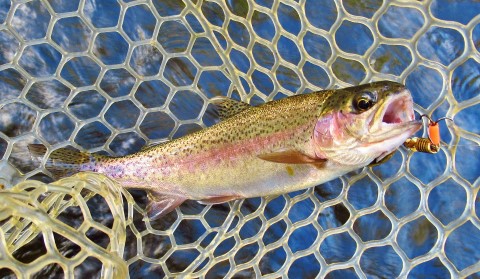 Sometimes things are never as easy as they sound, two days left in January to catch two trout to reach my 350th for the season, should be quite easy shouldn't, well it wasn't. Here's how I struggled to reach it. Never take things for granted.
Sometimes things are never as easy as they sound, two days left in January to catch two trout to reach my 350th for the season, should be quite easy shouldn't, well it wasn't. Here's how I struggled to reach it. Never take things for granted.
Trip one. Small tannin stream, 7:55 am to 10:30 am.
As the title states, getting my 350th trout wasn't easy at all, with just two trout needed to reach it I certainly did it the hard way. Every time I get close to achieving something, for one reason or another it never comes easy for me. In a way I suppose that's a good thing, but just for once it would be nice to reach it without any hiccups along the way. Like today for instance when I headed over to one of my favourite small tannin streams where I thought it would be a simple matter catching two trout to reach the 350th trout before the end of January. Now I don't normally fish the small tannin waters at this time of the year unless we've had some decent rainfall which we did have a week ago. When I arrived at the stream I could see it was on the low side but to me it still looked good enough to hop in and catch a few trout. The tannin water was still on the dark coloured side of things which I felt would be in my favour so I started the session off with a small #00 copper Aglia Mouche Rouge inline spinner.
- Written by Stephen Smith - Rubicon Web and Technology Training
- Category: Meander River
- Hits: 940
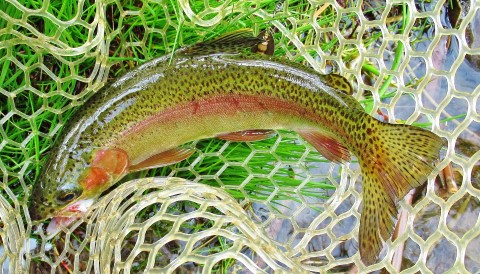 A cool change is on its way so I thought I had best get a spin session in before it arrives as the day goes on, this trip was close to home, it was to the Mersey River at Kimberley. It's an area I've fished for many years and it used to be a great area to fish until we had the 2016 record floods. That flood changed the majority of the Mersey River system, after the floods most of my favourite areas were completely washed away, the river was just a wide open river with five bridges destroyed or severely damaged and most of the river foliage gone. When everything settled down and I returned to fish the river it was like I was fishing a new river, the river had changed so much.
A cool change is on its way so I thought I had best get a spin session in before it arrives as the day goes on, this trip was close to home, it was to the Mersey River at Kimberley. It's an area I've fished for many years and it used to be a great area to fish until we had the 2016 record floods. That flood changed the majority of the Mersey River system, after the floods most of my favourite areas were completely washed away, the river was just a wide open river with five bridges destroyed or severely damaged and most of the river foliage gone. When everything settled down and I returned to fish the river it was like I was fishing a new river, the river had changed so much.
- Written by Stephen Smith - Rubicon Web and Technology Training
- Category: Mersey River
- Hits: 1044
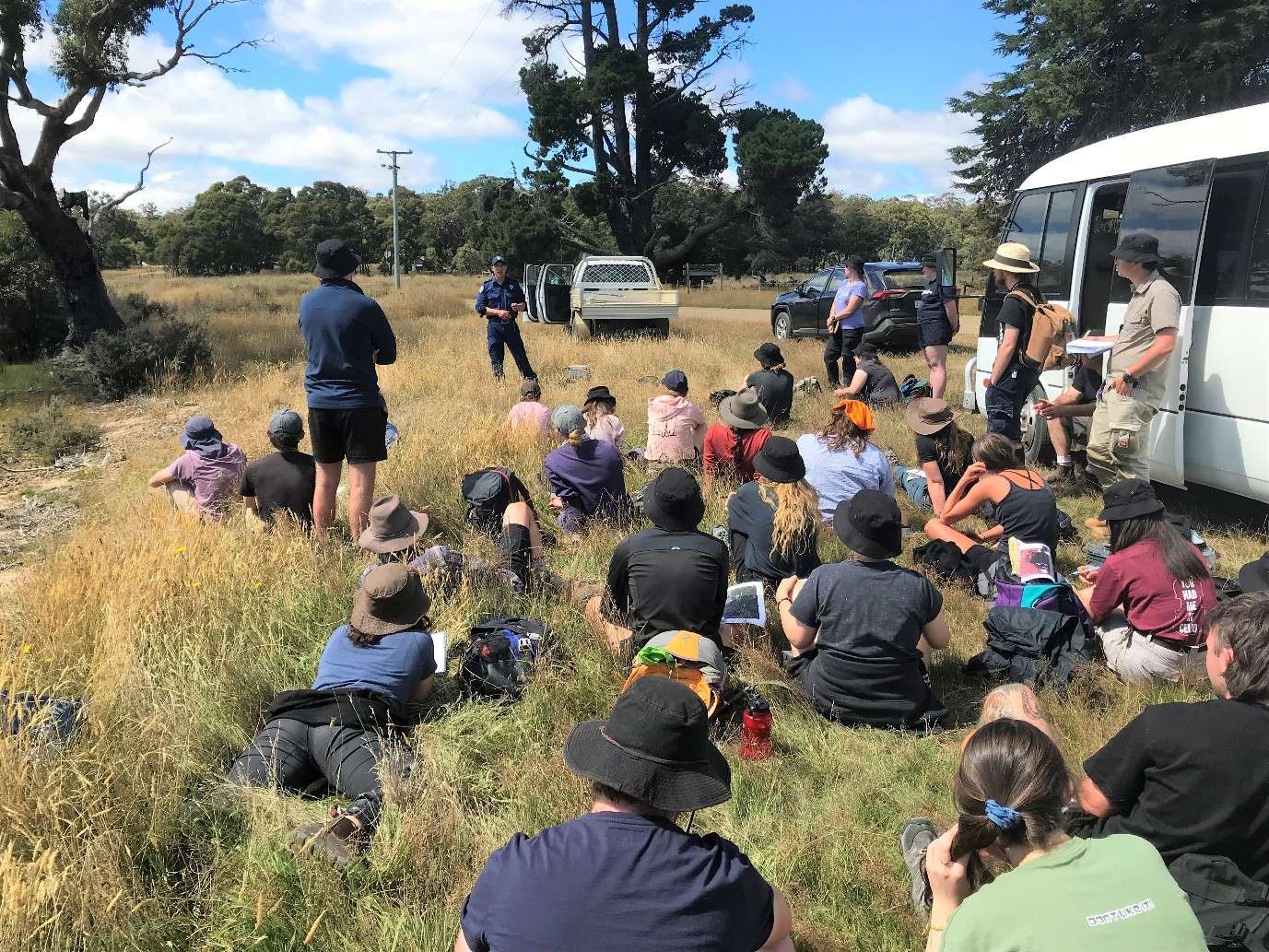 |
| Carp Management Program Leader Jonah Yick gives a presentation on the history and current status of carp in Tasmania to Utas Field Ecology students. |
In mid-February, 30 University of Tasmania (UTAS) students enrolled in the unit “Tasmanian Field Ecology”, visited Lake Sorell and Crescent to undertake vegetation and invertebrate surveys around the wetlands. The Interlaken Lakeside Reserve is internationally recognized under the Ramsar Convention on wetlands, and supports a range of threatened and protected flora and fauna. To commence the field trip, the students listened to a presentation given by the Carp Management Program Team Leader Jonah Yick, on the history of carp eradication in Lake Crescent, as well as an update on the ongoing carp eradication efforts in Lake Sorell. Jonah also gave the students a demonstration on the key techniques used to catch carp in the lakes, which included backpack electrofishers, gill nets, fyke nets, and radio telemetry equipment. This unit was coordinated by Associate Professor Leon Barmuta and Dr. Robert Wiltshire, who both taught Jonah over 17 years ago!
- Written by Stephen Smith - Rubicon Web and Technology Training
- Category: IFS, DPIPWE, MAST and Peak Bodies
- Hits: 1162
Did you know that through the new Infish App 2.0 you can get up to date notifications on fish stocking, the latest news and licensing. So if you haven't already download the app and follow the prompts below. The Infish app is free on iOS and Android.
- Written by Stephen Smith - Rubicon Web and Technology Training
- Category: IFS, DPIPWE, MAST and Peak Bodies
- Hits: 1556
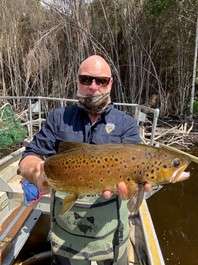 Last week we did a survey of the trout population at Camden Dam. This water was flooded for the first time during 2020-21. At full supply level it holds around 9,300 megalitres, supplying water to Scottsdale Irrigation Scheme. The dam captures inflows from the Camden Rivulet and several other smaller streams, so the potential for the recruitment of trout is very good. Rainbow trout are also found in some of the connecting streams.
Last week we did a survey of the trout population at Camden Dam. This water was flooded for the first time during 2020-21. At full supply level it holds around 9,300 megalitres, supplying water to Scottsdale Irrigation Scheme. The dam captures inflows from the Camden Rivulet and several other smaller streams, so the potential for the recruitment of trout is very good. Rainbow trout are also found in some of the connecting streams.
We used the electrofishing boat to sample trout from several areas of the dam. The number of trout captured, 26 from 4.5 hours of electrofishing, indicates the size of the brown trout population at present is low, but most fish were in very good condition. Over half of the fish collected were between 1.0 – 1.5 kg (see Figure 1), with the heaviest fish weighing 1.7 kg. There were signs of recruitment from last year with a small number of fish around 130 mm in length. In addition, significant numbers of river fish had dropped downstream and were captured in the bays where the streams flow in. Most fish were feeding on subsurface items such as aquatic beetle larvae and snails.
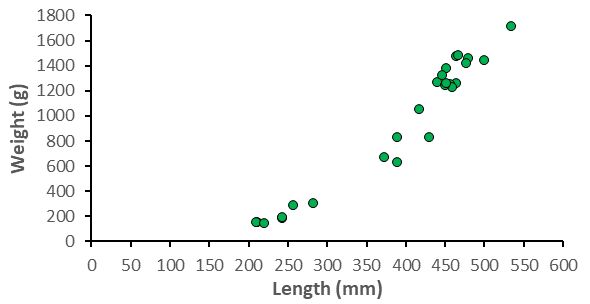
Figure 1: Length and weight plot for brown trout, Camden Dam, February 2022.
Camden Dam is showing promising results and is likely to continue to improve as a fishery over the next 3 – 5 years. Beyond this, the size of fish is expected to decrease as the population grows with high recruitment expected.
Source: https://www.ifs.tas.gov.au/news/2022/feb/16/camden-dam-trout-survey
- Written by Stephen Smith - Rubicon Web and Technology Training
- Category: IFS, DPIPWE, MAST and Peak Bodies
- Hits: 1533
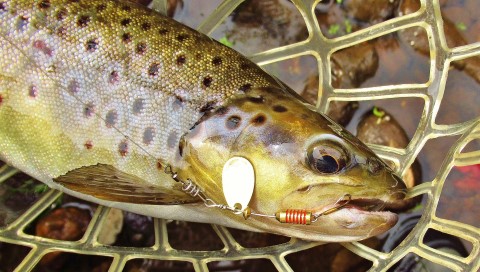 Today is another day and with more rain forecast later in the day I headed back to my favourite tannin stream to hopefully catch five trout to reach another achievement with my trout fishing. The weather this morning was quite good, very humid and no wind, the water level was down to an ideal wading and fishing height too. I was also hyped up and raring to catch the trout, whether it be the five I need or even better ten or more would be great. Once in the stream I started casting the little #00 White Miller Bug spinner directly upstream into a nice bubble line, then retrieved it while giving the lure a light twitch every so often.
Today is another day and with more rain forecast later in the day I headed back to my favourite tannin stream to hopefully catch five trout to reach another achievement with my trout fishing. The weather this morning was quite good, very humid and no wind, the water level was down to an ideal wading and fishing height too. I was also hyped up and raring to catch the trout, whether it be the five I need or even better ten or more would be great. Once in the stream I started casting the little #00 White Miller Bug spinner directly upstream into a nice bubble line, then retrieved it while giving the lure a light twitch every so often.
- Written by Stephen Smith - Rubicon Web and Technology Training
- Category: Trout Fishing
- Hits: 1641
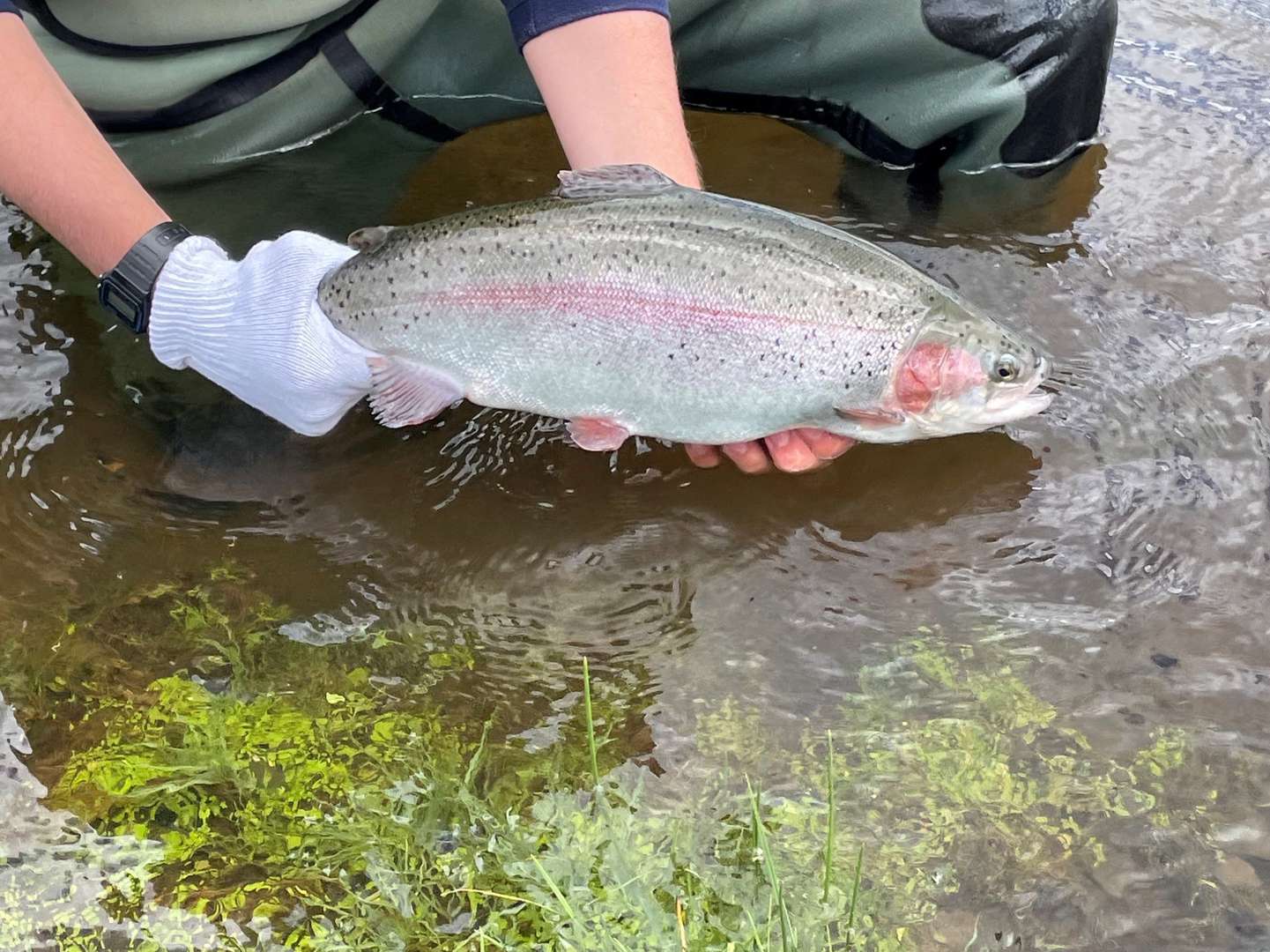 |
| A rainbow trout being released into Brushy Lagoon |
The release of rainbow trout into regional public waters continued with 750 into Brushy Lagoon and 140 into Lake Kara yesterday. The fish averaged 1.3kg but ranged up to 2kg. This will provide some exciting fishing over the coming months.
For more information about access and the rules for these waters see the brochure for Brushy Lagoon and the fact sheet for Lake Kara.
Thanks to the Huon Aquaculture Group for donating these fish.
Source: https://www.ifs.tas.gov.au/news/2022/feb/04/rainbow-trout-to-the-nw-coast
- Written by Stephen Smith - Rubicon Web and Technology Training
- Category: IFS, DPIPWE, MAST and Peak Bodies
- Hits: 1324
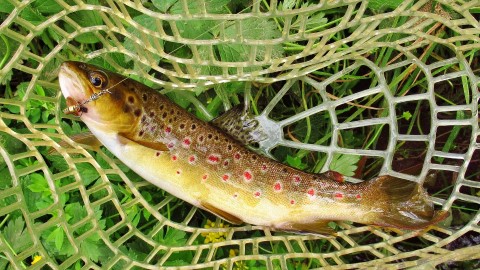 Today's mid afternoon trip was to one of my favourite tannin streams and my aim was to catch four trout to reach my 300th of the season. The conditions weren't all that good with an Easterly breeze, warm day with plenty of sun and a higher than normal water level. The one thing I disliked about today was that it's a good day for snakes, I had to walk through a lot of high grass and fallen tree branches to reach my entry point into the tannin water. It was 2:55 pm by the time I hit the water and started to flick a small #00 gold Aglia spinner into a small section of dark tannin water where I had a trout follow the lure on the first cast and retrieve. It was on the second cast and retrieve when a small brown trout took a liking to the gold Aglia, the first trout of the session was soon in hand. Even though it was a small brown trout this was just the start I was looking for, I was hoping it will continue to keep on going too.
Today's mid afternoon trip was to one of my favourite tannin streams and my aim was to catch four trout to reach my 300th of the season. The conditions weren't all that good with an Easterly breeze, warm day with plenty of sun and a higher than normal water level. The one thing I disliked about today was that it's a good day for snakes, I had to walk through a lot of high grass and fallen tree branches to reach my entry point into the tannin water. It was 2:55 pm by the time I hit the water and started to flick a small #00 gold Aglia spinner into a small section of dark tannin water where I had a trout follow the lure on the first cast and retrieve. It was on the second cast and retrieve when a small brown trout took a liking to the gold Aglia, the first trout of the session was soon in hand. Even though it was a small brown trout this was just the start I was looking for, I was hoping it will continue to keep on going too.
- Written by Stephen Smith - Rubicon Web and Technology Training
- Category: Trout Fishing
- Hits: 1017
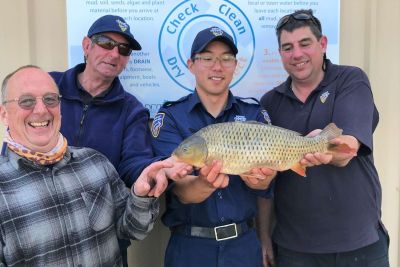 |
| A happy crew with a female carp caught in Lake Sorell |
High rainfall in October resulted in Lake Sorell rising quickly. By the start of November, Lake Sorell was 150mm over the full supply level. The last time the lake had filled to this level was in October 2016, when there was still a quite large population of carp, and many were caught in traps set in barrier nets in front of the marshes. With the lake level and temperature also rising at a similar time this year it provided a good chance to test the theory that few carp were left, and to catch any remaining carp in the lake. The strong spawning cues were likely to draw carp into the shallows, making them easier to catch. However, it also meant that we had to be on high alert, given the risk of spawning in the marshes was possible.
The fishing strategy for the 2021/22 carp season was to focus on spawning related carp movement and blocking spawning. This has included blocking the marshes with barrier nets, trapping the preferred carp entrance points to these areas, and targeted gill netting combined with electrofishing.
Fishing started in late October, and a total of four carp have been caught up until the end of December. One carp was caught in a trammel net set while using the electrofishing boat, another was caught in a trammel net set behind the barrier net in the marshes, while two carp were caught in barrier traps. The carp ranged in size from 800 to 2344 grams, and all four were females. Of the four females, three of the fish had gonad tumours and could not spawn. The other female carp appeared to healthy, carrying 334gm of eggs, with a gonadosomatic index (GSI) of 20% which is quite high. However, all the eggs were completely intact, indicating she had not spawned. The last healthy, sexually mature male carp was caught on 16 December 2018. It is increasingly likely that any remaining carp in Lake Sorell are unable to breed.
41 503 carp have now been removed from Lake Sorell since their discovery in 1995. There has been no sign of spawning so far from juvenile carp surveys this season. Surveys will continue each month through until March. These surveys involve electrofishing with the boat and backpack, fine mesh dip netting, fine mesh fyke netting, and visual checks in spawning habitat. Targeted fishing will continue into January if good weather conditions arise.
Source: https://www.ifs.tas.gov.au/news/2022/jan/06/lake-sorell-carp-eradication-update
- Written by Stephen Smith - Rubicon Web and Technology Training
- Category: IFS, DPIPWE, MAST and Peak Bodies
- Hits: 1449
Subcategories
Current TFBN
Click above for current issue content. The current issue of TFBN is extensive and topical. In Tackle Stores, Newsagents and by subscription.
Delivered to your door for $48 for 2 years (8 issues). To subscribe, send Mike $48 via www.paypal.com.au . (Basic instructions are here) The email is at Contact Us. Your address will be included from PayPal.
Or phone Mike with your c/c handy on 0418129949
Please ensure your details are correct, for Mike to organise delivery.
TFBN Newsletter Sign up Form
Why not submit an article ?
When you have finished for the day, why not have a brag about the ones that didn't get away! Send Mike an article on your fishing (Click here for contact details), and we'll get it published here. Have fun fishing - tasfish.com
Category Descriptions
Here is a list of all of the Article Categories. The number in Brackets, eg (13) is the number of articles. Click on Derwent River and all articles relating to the Derwent will be displayed in the central area.
Articles by Category
-
Rivers (3)
-
Saltwater and Estuary Fishing (149)
-
Kayak Fishing (34)
-
Lakes (1)
-
Great Lake (62)
-
Lake Leake (52)
-
Woods Lake (16)
-
Lake Augusta (11)
-
Huntsman Lake (13)
-
Lake Pedder and Gordon (10)
-
Lake Dulverton (5)
-
Lake Crescent (6)
-
Tooms Lake (10)
-
Lake Mackintosh (2)
-
Lake Barrington (5)
-
Little Lake (8)
-
Meadowbank Lake (5)
-
Lake King William (7)
-
Lake St Clair (2)
-
Western Lakes (12)
-
Arthurs Lake (35)
-
Lake Echo (7)
-
Four Springs (54)
-
Lake Sorell (7)
-
Lake Burbury (6)
-
Other Lakes (57)
-
Brushy Lagoon (18)
-
Little Pine Lagoon (5)
-
Penstock Lagoon (16)
-
Brumbys Creek (7)
-
-
Events (48)
-
Estuary Fishing (0)
-
Coastal Catches (46)
-
Super Trawler (46)
-
IFS, DPIPWE, MAST and Peak Bodies (435)
-
Commercial Interests (98)
-
Other (24)
-
TFBN Back Issues (8)
-
Fly Fishing (67)
-
Trout Fishing (250)
-
Meteorology and Weather (8)
-
Jan’s Flies (50)
-
Tuna Fishing and other Game Fishing (86)
-
Cooking Fish (19)
-
Fishing Information (1)
-
Fishing Books (8)
-
Videos (5)
-
Tackle, Boats and other Equipment (146)
-
World Fly Fishing Championship 2019 (2)
Popular Tags
windyty.com
Visit https://www.windyty.com/
Rubicon Web and Technology Training
Hello everyone, I thought it would be a good time to introduce myself.
My name is Stephen Smith and I have been managing the website tasfish.com since May 2009.
It has been an epic journey of learning and discovery and I am indebted to Mike Stevens for his help, support and patience.
I am developing a new venture Rubicon Web and Technology Training ( www.rwtt.com.au ). The focus is two part, to develop websites for individuals and small business and to train people to effectively use technology in their everyday lives.
Please contact me via www.rwtt.com.au/contact-me/ for further information - Stephen Smith.
From the Archives ... (last chance)
Sea runners - Early Season Excitement - Christopher Bassano
Presented from Issue 100
Considering the world class quality of our sea trout fishery, these fish are not sought after by enough anglers. Sea runners live in the salt water and run up our estuaries and rivers from the start of August to the middle of November. At this time of the year, they are here to eat the many species of fish that are either running up the rivers to spawn or are living in and around the estuary systems. Trout, both sea run and resident (Slob Trout) feed heavily on these small fish which darken in colouration as they move further into fresh water reaches.
The majority of these predatory fish are brown trout with rainbows making up a very small percentage of the catch. They can be found all around the state but it would be fair to say that the east coast is the least prolific of all the areas. They still run up such rivers as the Georges (and many others) but their numbers along with the quality of the fishing elsewhere make it difficult to recommend the area above the larger northern, southern and western rivers.
Read more ...


